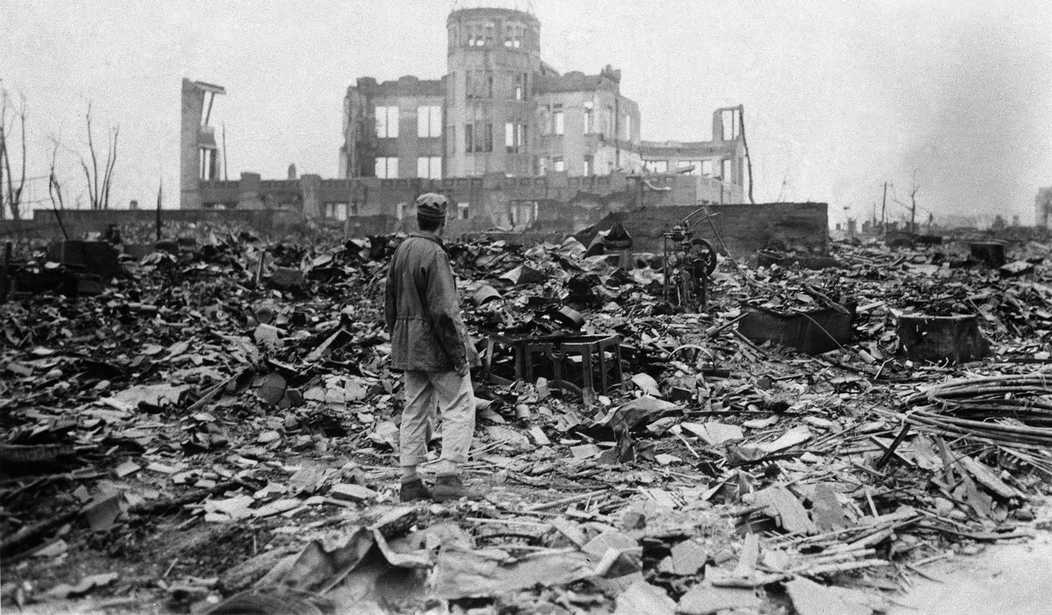Most people today assume that our understanding of WWII is largely complete, thanks to the enormous quantity of books, TV series such as ITV’s classic 1970s documentary The World at War, the myriad of documentaries that aired in the early days of the History Channel cable TV network, and the unending series of movies produced by Hollywood, particularly when compared to its predecessor, WWI. But classicist historian and fellow PJM columnist Victor Davis Hanson does yeoman’s work unpacking the events of 1939-1945.
Starting with the plurality in the title, Hanson’s 2017 book, The Second World Wars: How the First Global Conflict Was Fought and Won emphasizes the disparate nature of the War’s myriad battles. Hanson also explores the enormous difference in mindsets between the leaders of the Axis and Allied powers. He makes plain their difference in desired outcomes right on page three, when he notes, “The Axis losers killed or starved to death about 80 percent of all those who died during the war. The Allied victors largely killed Axis soldiers; the defeated Axis, mostly civilians.”
Curtis LeMay Repurposes the B-29
The Allies were also able to improvise and adjust tactics far more easily than the Axis, Hanson writes:
The same asymmetry was true at sea, especially in the Battle of the Atlantic. The Allied leadership made operational changes and technological improvements of surface ships and planes far more rapidly than could the U-boats of the Kriegsmarine. America adapted to repair and produce aircraft carriers and train new crews at a pace inconceivable in Japan. The Allies—including the Soviet Union on most occasions—usually avoided starting theater wars that ended in multiyear infantry quagmires. In contrast, Japan, Germany, and Italy respectively bogged down in China, the Soviet Union, and North Africa and the Balkans.
While Curtis LeMay is largely remembered today along the lines of the caricatures performed by Sterling Hayden and George C. Scott in Doctor Strangelove, VDH dramatically describes Curtis LeMay’s improvisational efforts at reconfiguring the untested and technologically complex (read: glitch-filled) Boeing B-29 from a high-altitude precision bomber to massive low-altitude fire bomber at a key moment in the final stages of the war against Japan:
Rather than flying high and relatively safely in daylight as intended, LeMay’s B-29s would now go in low at between five and nine thousand feet. The squadrons, in British fashion, would bomb mostly at night, and, at least during the first three incendiary missions, without their standard full defenses or reliance on precision bombsights. Staying at low altitude spared the temperamental engines, saved fuel by obviating climbing to required higher altitudes, and upped the payload of bombs to ten tons and more, an incredible load for prop-driven bombers. Mixed loads of new M-69 napalm incendiaries, combined with explosive ordnance, meant that the notorious Japanese jet stream was now an ally, not an impediment, to the B-29s’ destructiveness, spreading the inferno rather than blowing conventional bombs off target.
Because of the way that the Japanese had dispersed their wartime industries among their civilian populations, the fire-bombings would create enormous amounts of civilian deaths, even before the dropping of two atomic bombs. This was of course, contrary to “the entire moral pretenses of the US precision strategic bombing thus far in the war,” Hanson writes. LeMay grudgingly accepted this, Hanson explains. “When Japanese production dropped, LeMay logically took credit and defended the high civilian death tolls. He enjoyed the role of a take-no-prisoners general, but beneath his crusty exterior, like George S. Patton, he was one of the most introspective, analytical, and naturally brilliant commanders of the war. If he was a frightening man in his single-minded drive ‘to put bombs on the target,’ he was also an authentic American genius at war.”
One of the Greatest Blunders of WWII
The idea that Americans had any “geniuses at war” would have shocked the leaders of the Axis powers at the beginning of the conflict. As VDH notes, “Luftwaffe head Hermann Goering scoffed to the American news correspondent William Shirer in Berlin in November 1939, just two months after the invasion of Poland, ‘if we could only make planes at your rate of production, we should be very weak. I mean that seriously. Your planes are good, but you don’t make enough of them fast enough.’”
Presumably, that dismissive attitude towards an America recovering from the Great Depression played a role in the calculus behind Hitler’s decision to declare war on the U.S. only a few days after Japan attacked Pearl Harbor. Hanson describes December 11, 1941, as “one of the greatest blunders of World War II:”
If Germany had not done this, there is no reason to assume that the United States would not have concentrated all its resources on Japan after Pearl Harbor. Hitler’s disastrous decision may have been in part emotional; he had a pathological hatred for Franklin Roosevelt, as he had indicated in a number of marathon speeches, most notably an April 1939 diatribe before the Reichstag. Hitler’s decision was in part also an ad hoc response to the lobbying from the German navy, whose submariners wanted to target US convoys at their source, and a general frustration that the supposedly mongrel and profit-minded Americans were supplying enemies of the Third Reich with Lend-Lease.
As a result of America entering the war in Europe, and due to heavy losses on the Eastern Front, by the end of war, a strange disparity emerged in Germany. As allied bombers systematically smashed Nazi assembly lines producing proven tanks, aircraft, and artillery, German engineers increasingly fixated on advanced technologies such as the V-1 (the first cruise missile) and the V-2 (the first ICBM). This was on par with the over-engineered nature of existing tanks such as the Tiger 1. Built to take on the Russian T-34, the Tiger suffered from high fuel consumption, and its complex interweaved wheels were vulnerable to the brutal ever-present snow and ice of winter, and the muddy aftermath of spring, on the steppes of Russia.
That same worldview applied to Germany’s army as well:
The German soldier was seen as a sort of craftsman, a human extension of the pride in workmanship that had produced a Panther tank that was technically superior to the American Sherman but that could never have been built in similar numbers or with commensurate reliability and ease of use. When American generals such as George S. Patton sought to recreate the American foot soldier as a deadly killer analogous to the German (“Americans love to fight—traditionally! All real Americans love the sting and clash of battle”), his speeches and rules became the stuff of popular caricature that for many explained his later near-career-ending slapping incidents.
In contrast, American tanks such as the Sherman lacked the firepower of an individual Tiger, but overwhelmed the Germans due to the sheer number of them being built on American assembly lines. Assembly lines that were free of German interference, because despite their obsession with advanced technology, the Nazis never saw fit to build a four-engine heavy bomber with sufficient fuel range to reach either America or the Urals, where Stalin moved the Soviets’ manufacturing base. As VDH writes, ultimately, “the Allies understood history far better: in any existential war, only the side that has the ability to destroy the homeland of the other wins.” Later, he notes that “German bombers could never reach most of the Russian industry that before and during the war had been transferred beyond the Urals, and the Luftwaffe thus had almost no ability to substantially curb Russian military production.”
During the first years of the war, “German strategists had also assumed that blitzkrieg resulted inevitably in short wars that precluded the need for long-term strategic pounding of faraway enemy industry,” VDH writes. “In part, Hitler was already thinking of miracle weapons such as guided missiles and jet aircraft that might preclude the need for heavy bombers. Yet paradoxically the huge investment in 1943 in jets and the V-rockets made it difficult to continue to fund adequately a heavy bomber program.”
VDH writes that Stalin had another source of materiel. Despite the Axis’ alleged unity between Nazi Germany and Imperial Japan:
The Japanese-Soviet Neutrality Pact (signed April 13, 1941), welcomed by Yamamoto, had ensured that Japan would never closely coordinate with its German partner in a possible joint attack on two fronts against the Soviet Union, and thus turned Japanese attention to naval warfare in the Pacific and against America in particular, with disastrous results… Japan’s nonintervention nonetheless guaranteed that the beleaguered Soviet Union would avoid a two-front war and would have Vladivostok free to receive unimpeded US Lend-Lease aid from West Coast ports of America.
Even before the end of the war ushered in the atomic era, technology transformed the way WWII was fought. Occasionally simple technology was paired in new ways with the then-cutting edge. While Tigers and T-34s were the dominant weapons on the Eastern Front for much of WWII, in the last months of the war, VDH writes that Russia pushed into Germany with not just tanks, but with a fleet of simple, sturdy trucks (many of which were lend-lease Studebakers built in America) armed with batteries of Katyusha rocket launchers mounted on their beds. The rockets’ primitive battlefield delivery system had key advantages, Hanson writes. “The truck-mounted Katyushas could fire and leave from the launching site far more quickly than could even the most mobile artillery.”
As for Mussolini’s Italian Fascists:
While Italian military craftsmanship was always superb and would produce some excellent ground weapons and prototypes—the Carro Armato P26/40 tank, SPA-Viberti AS.42 armored car, assorted 75 mm and 100 mm medium field-artillery pieces, or the Beretta Model 38 submachine gun—the fascist state had no serious concept of mass production, much less the resources to fuel it. The few competitive weapons that Italy produced either came into production too late in 1943 or in too few numbers.
This lack of production led to some comical moments in retrospect, including the Italians participating in the Battle of Britain with biplanes:
My only complaint with The Second World Wars is that I wish there was a bit more about how the Holocaust was so tightly integrated into the Nazis’ wartime efforts. As Robert D. King writes in the May issue of Commentary in his review of the biography of historian Lucy Dawidowicz, the author of The War Against the Jews 1933–1945, she remains “the leading representative of the ‘intentionalist’ theory of Nazism—Hitler waged war intentionally to annihilate the Jews—in opposition to the ‘functionalist’ theory: that Hitler wanted to gain a lot of things in going to war, and the Jews of Poland and Eastern Europe just happened to be in the way.” Given the resources Hitler devoted to the Final Solution, the ‘intentionalist’ theory seems like the only opinion to take.
But that quibble aside, obviously, The Second World Wars is a magisterial work, and highly recommended to any student of history.










Join the conversation as a VIP Member